According to Fenergo estimates “poor customer experience” is costing financial institutions $10 billion in revenue per year. 36% of financial institutions have lost customers due to inefficient or slow onboarding, and 81% believe poor data management lengthens onboarding and negatively affects customer experience.
How do you encourage users to not only rank your app with 5 stars in the Apple Store and Google Play but also gain their loyalty and trust? It’s no secret that the digital customer experience today is what differentiates demanded financial brands. The main struggle is keeping up by creating a digital banking customer experience that WOWs.
Financial services customer experience refers to customer interactions with their bank, typically including online and mobile banking services, visiting a physical branch, or speaking with customer service representatives. The digital banking customer experience (digital banking CX or UX – user experience) consists of all the emotions, thoughts and behavior of a customer triggered in using a digital banking service. A banking customer experience is generated by all digital products and brand ecosystems, including previous customer engagements and future expectations.
The goal of improving customer experience in financial services is to make banking services as convenient, efficient, and pleasant as possible for the customer. This can be achieved through various means, such as offering an appropriate range of services and features, providing clear and helpful information and assistance, and ensuring that the customer’s interactions with the bank are smooth and hassle-free. Make sure that financial service customer experience aligns with brand identity and business strategy. At the same time, remember that in the digital age, brand reputation is no longer a guarantee of loyalty and can be instantly damaged by a problem with a mobile application caused by poor CX / UX design since the customer experience is a highly dynamic process.
I would like to describe 5 ways in which you can improve digital CX of financial service in 2024:
1. Establish Experience Mindset
The development of digital technology is disrupting all the industries. What has been proven to work for decades, like traditional marketing and product approach, has stopped working. The world is making new demands on businesses, and the financial industry is no exception.
Today, customers have dozens of new alternatives every year due to low entry barriers and open banking. That’s why, in order to survive in the digital age, financial brands are required to adopt an absolutely new way of thinking and operating a business.
Social networks, information transparency and demand for sustainability challenge businesses to put the people first by becoming customer-centered and deliver experiences instead of manipulating customers to reap profits. That’s why the future of the banking industry depends entirely on how the new generation of bankers can bring their mindset in line with the digital age to provide the best possible banking customer experience.
There are five key attitudes that can be integrated into a company’s DNA with the aim to make the team mindset purpose-driven and shift the business culture toward success in the digital age.
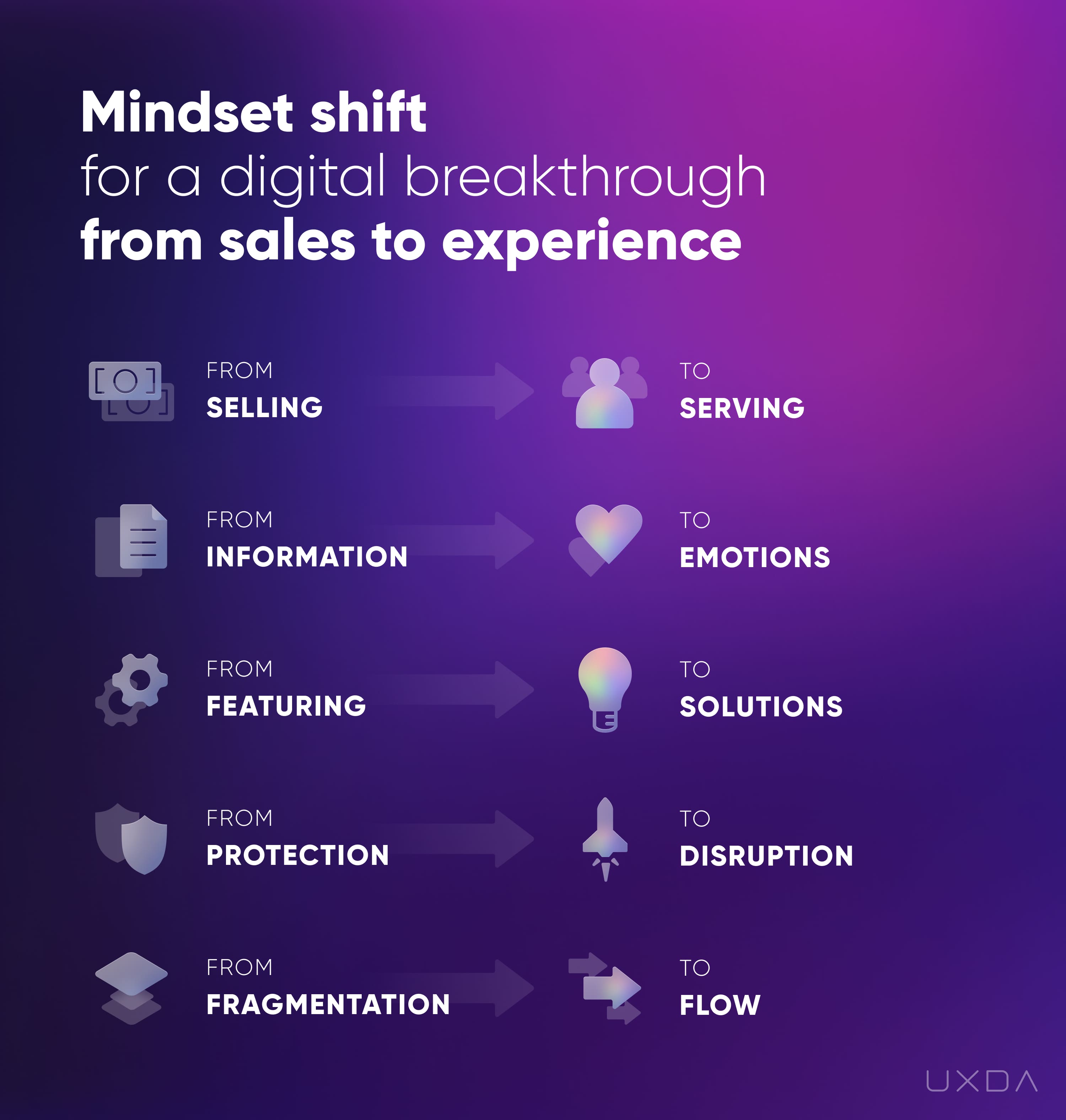
- Serve Instead of Sell. The “sell” priority is all about focusing on marketing and looking at people as numbers behind conversion. Design, in this case, is only about using attractive packaging to sell more, and UX is just one more tool to manipulate user behavior. To focus the business team on customer needs, feelings and behaviors, we need to prioritize “Serve.” In this case, conversion became just a metric to evaluate product clarity, because the main aim is to provide real benefit for the customer. And, a lot of customers will appreciate it, using the digital space to express their gratitude and attract more users.
- Emotions Over Information. People often forget information but remember experiences, and those are created from emotions. That’s why information should be integrated into a context of usage. It should become an organic part of the banking user experience that is based on emotions, because emotions are the main language to communicate with the customers and understand their needs and expectations.
- Solution Instead of Features. Don’t make your users have to think about how to use hundreds of offered features. Instead, provide them with an easy to use solution. According to psychology experiments, too many options can cause decision paralysis. Users don’t come to you for the hundreds of options you can offer. They have a specific problem and goal in mind that your financial product has to help to achieve.
- Disruption Over Protection. Traditional banks and other well-established businesses are focused on protecting their legacy and maintaining the corporate image. That’s why change comes slowly and painfully. Instead of thinking about how to protect their products from the digital challenge and prevent customers from leaving, banks have to figure out how to stop self-deception and disrupt themselves and their competitors. In the experience age, self-disruption is the only way to provide meaningful and pleasant products for users.
- Create Flow, Avoid Fragmentation. It is a common mistake to view services and products as separate parts. But, the human brain perceives experiences holistically – as a whole entity. Customers see the product as a continuous experience flow, even lasting for years. Transition to the same thinking is the only way for businesses to ensure a delightful user journey. We need to detect links among user needs, emotions, behavior and service features, design and strategy. Separation of service elements by different departments caused by organizational silos fills the customer experience with friction. We need to defragment business and ensure a frictionless flow that makes service pleasant.
2. Focus on the Unique Product Value Proposition
Finance companies that actively implement the work principles of the purpose-driven mindset aim to bring maximum value to the user. In exchange, the customer gladly rewards the company with loyalty and supports its development by recommending their services.
The central question in the creation of any financial product is WHY it is needed. What exactly makes the product valuable and unique to the users? What problems will it solve, and what benefits will it provide? By not treating all of these questions with dignity, the financial company is risking its product quickly sinking into the “red ocean” of competition.
There are concrete product growth stages that depend on the level of competition and the demand from the customers. Understanding these stages helps to define and create the perfect match between the financial product’s value proposition and the market demand, leading to success.
The competition is what requires finance entrepreneurs to step out of the box and identify customers’ expectations. The bigger the competition, the greater the need for market advantage to conquer the competitors.
If financial product functionality is not enough to compete, provide usability. If all the competitors have the same functionality and usability, add aesthetics. If you need even more of an advantage, connect the product with the customer’s lifestyle by personalizing it and making it a symbol of their status. And, finally, you can go even further and state the mission to deliver the ultimate value that will change the world and gain followers who look up to you.
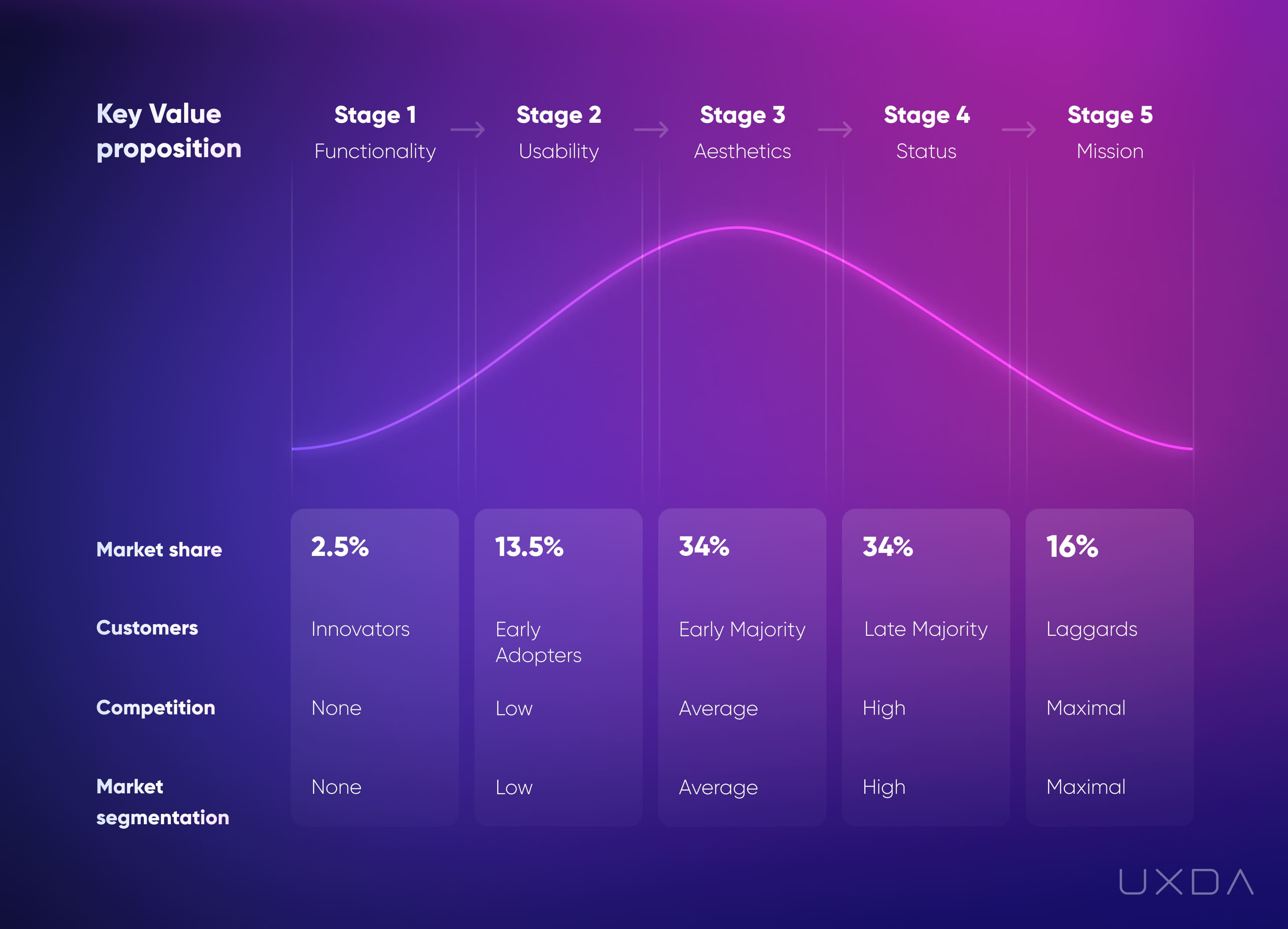
Targeting the unique Product Value proposition through Mission, Status, Aesthetics and Usability help to maximize the needs of users through customer-centered product design.
Modern banks have already provided their customers with basic service functionality. Innovations in the digital banking industry have moved from the Functionality stage to the Usability and Aesthetics stages to create an emotional bond with customers.
Despite that, there are still many traditional banks that struggle with Usability. Meanwhile, progressive FinTechs are quickly climbing up the ladder, reaching the Status stage by personalizing and providing digital financial services that are enjoyable, attractive and serve the needs of specific audiences.
3. Integrate the Design Approach Across All Levels
By focusing on the usability, aesthetics and status of the product, you can engage digital users, but this is not enough. To ensure a long-term market need for your product, it is necessary to integrate customer-centricity into all levels and processes of the company, putting the user at the forefront.
In many cases, incorrect design integration in the process of product creation leads to harmful consequences. It’s like in construction: a skyscraper can’t stand without a well-thought-out and grounded architectural plan. The financial product with amateur UX will lack demand in the market, could be rejected by the users, often exceeds the development budget or doesn’t even get launched at all.
There are five mutually connected areas in which the design approach can be integrated to ensure the best possible customer experience in the long term. In general, these five areas match the main elements of business development.

When you have a solid business idea, you need to create a business model by defining the key Processes that will help you reach your desired goal. Here you can make a design approach empowering fuel in all of your financial business processes.
In the next step, you need a Team of specialists who are qualified to execute your idea. At this point, make sure to add financial UX design expertise from people who have mastered digital products in finance.
When you have found professionals who match your challenge, you need them to take the right Actions that move you closer to product realization. Accelerate design impact by defining results-driven actions.
To be sure you are moving in the right direction, you have to evaluate the Results your team is producing. You should measure the quality of design by the way it serves your customers.
In the end, if all of the previous steps have been accomplished successfully, you can grasp the unique Value your financial product will provide to the customers, turning the digital product into a success story.
4. Use the Proper CX Design Methodology
As a typical business delivery starts with Process and ends with Value to customer, then the easiest way to design the best possible digital experience is to do it in reverse. We should start with defining the ultimate Value for the customer and only then move on to an action plan.
We can compare reverse engineering to a maze that has multiple entrances and only one exit. The entrances are different types of product configuration, functionality, and features, and the exit is the high demand and success in the market.
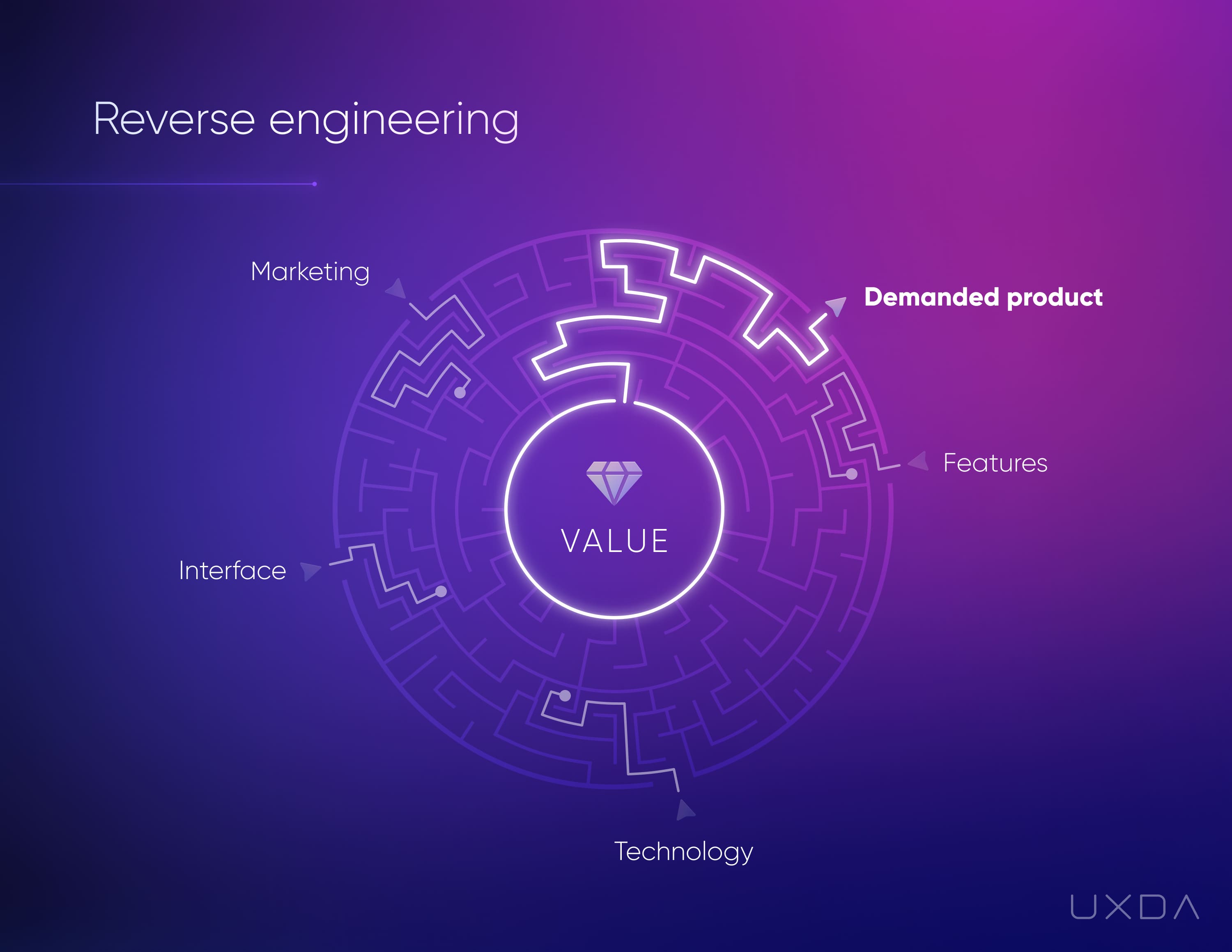
Usually, entrepreneurs try to guess which configuration they should develop to gain success. They look around to identify what products are trending, code a lot of features to impress customers and finally pack all this into a vibrant design to grab attention. Then they spend tons of money on advertising to convince consumers that they need this.
In reverse engineering, you significantly reduce uncertainty by starting from the maze exit and moving to the correct entry point. In this case, the exit of the maze is the point at which the product is highly demanded because of the value it provides to customers. By using the CX / UX design approach, we are exploring the value that’s significant to customers and putting the focus of the product and the entire business on the needs of customers.
Though CX and UX design is trending today, only a few financial product experts are capable of successfully translating it into architecture and the user interface of a particular product because it requires knowledge in human psychology, behavior and design arts. Perhaps this explains why most of the financial solutions around us still look outdated and amateur, despite the multiple designers involved in the product development teams.
Designing a customer-centered financial product that’s based on the value for users consists of three key elements: Design thinking, Business/User/Product frame and UX design tools.
Design thinking is the basis of Financial UX Methodology. It provides a methodical, iterative approach to explore and serve the key user needs through its five stages – Empathize, Define, Ideate, Prototype and Test.
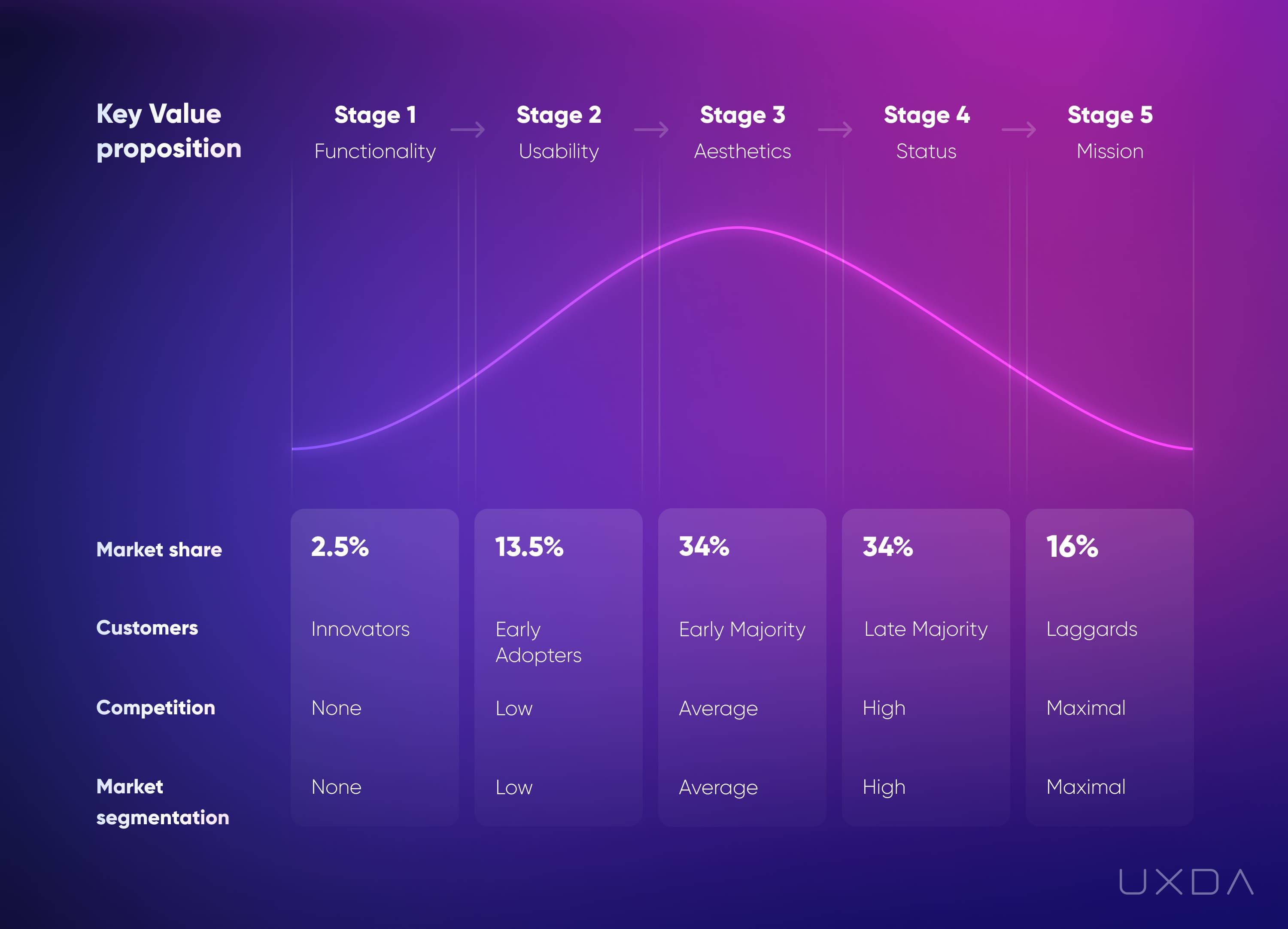
To ensure overall success, we have to implement all five parts of the Design thinking process through a Business, User and Product perspective. This way, we find, define and materialize the maximum value and gains for each of them.
Finally, UX design tools provide the best way to execute the whole process ensuring effective results-based financial product transformation.
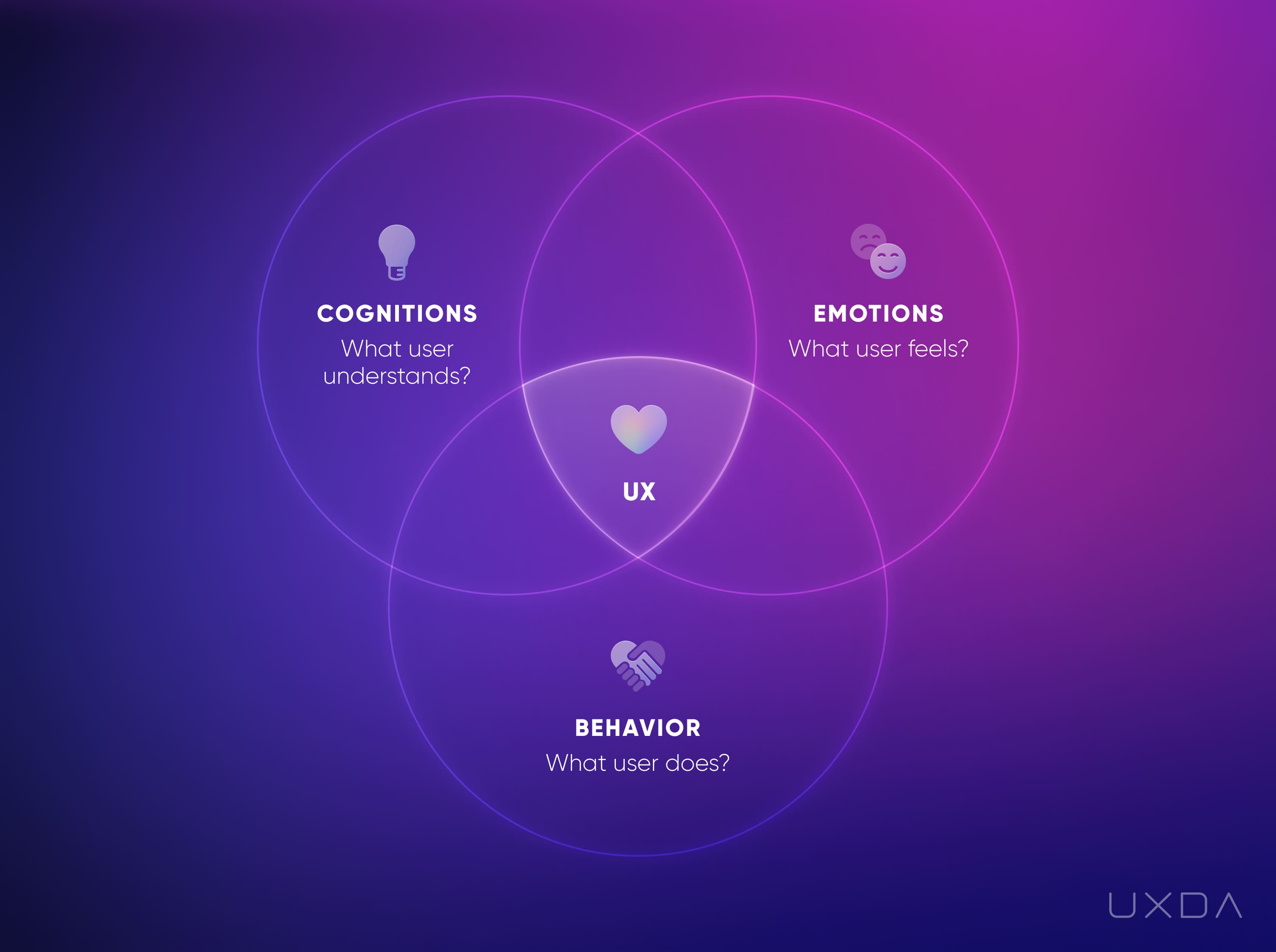
5. Explore the Context of Your Customers
At this point, you might feel like you have enough powerful knowledge to go straight to addressing your customer problems with your financial service experience design. Yes, it all starts with a good solution to an important problem. But, between the problem and the solution, there are three crucial conditions that differentiate whether or not a product will match real users’ needs.

To create a demanded digital financial service that will be loved by the customers, we start with the problem.
To clearly define the problem and the tasks, we explore the problem-solution cycle’s impact on the banking customer experience by creating user personas and defining their jobs to be done.
Throughout this process, we crystallize the context in which the problem takes place, the motives of the users that dictate the actions and the people it will take to apply the right solution.
During this process, Financial UX Design Methodology and such UX tools as an Empathy map, Red Route Map, UJM, user flows, wireframes, UI design and testing are used.
- SEO Powered Content & PR Distribution. Get Amplified Today.
- PlatoData.Network Vertical Generative Ai. Empower Yourself. Access Here.
- PlatoAiStream. Web3 Intelligence. Knowledge Amplified. Access Here.
- PlatoESG. Carbon, CleanTech, Energy, Environment, Solar, Waste Management. Access Here.
- PlatoHealth. Biotech and Clinical Trials Intelligence. Access Here.
- Source: https://www.finextra.com/blogposting/25474/five-ways-to-improve-customer-experience-in-financial-services-in-2024?utm_medium=rssfinextra&utm_source=finextrablogs



